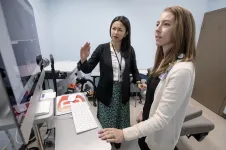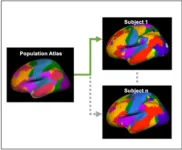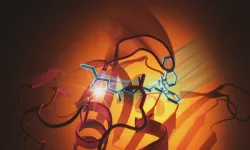(Press-News.org) Neuroscientists from the Medical University of South Carolina (MUSC) report in Brain Connectivity that they have detected subtle differences in the way the brain functions in older adults with preclinical Alzheimer’s disease (AD).
Adults with preclinical AD have the earliest signs of disease, such as buildup of amyloid-beta proteins in their brains. However, they have no noticeable symptoms of cognitive decline.
The research team, led by Andreana Benitez, Ph.D., and Stephanie Fountain-Zaragoza, Ph.D., used a novel brain imaging analysis technique to construct individualized maps of brain function. They then looked to see if there were links between subtle changes in brain function and declining cognitive performance, assessed using behavior-based tests. This approach could improve the ability to study the preclinical phase of AD.
“Prior studies have not found an association between brain function and behavior in preclinical AD,” said Benitez. “Using these individualized maps of brain function, we found a potential brain-based reason for very subtle cognitive changes in this early phase of the disease.”
Detecting subtle changes in brain function with improved brain mapping
Research into the preclinical phase of AD could help us to understand how the disease begins and progresses. However, early changes in brain function are very subtle, making them challenging to study. With pilot project funding from the South Carolina Clinical & Translational Research Institute, the MUSC researchers used a new form of brain mapping to detect these subtle effects.
They looked at brain activity using a functional connectome – a type of brain map that measures how different brain regions communicate with one another. Think of the brain like a big city, said Fountain-Zaragoza, where brain regions are clustered into neighborhoods connected by highways. The functional connectome is like watching the activity across that city – how much there is going on within each neighborhood and how well traffic flows between them.
The researchers relied on a newer and highly sensitive form of image analysis to appreciate how these neighborhoods function in individuals. The technique – the individualized functional connectome – was developed by their collaborator Hesheng Liu, Ph.D.
Traditional functional connectomes use an average of many people’s brains as a map for functional brain regions. In contrast, Liu’s method can show the unique patterns of brain function for each individual.
“We all have the same functional parts of our brain, but they're positioned slightly differently, sort of like a fingerprint,” said Fountain-Zaragoza. “This method creates an individualized brain fingerprint that more accurately reflects where the different functional regions are in each individual’s brain.”
Linking subtle changes in brain function to behavior
The researchers used this novel brain fingerprinting technique to look for subtle changes in brain function in 149 participants age 45 to 85 without signs of cognitive decline. All participants underwent PET scans of their brains and were divided into two groups – those with and without PET scan evidence of early amyloid-beta protein buildup. The participants also underwent MRI scans, which were used to generate the brain fingerprints.
The researchers then tested how well the participants in each group performed on behavior-based tests of information processing. They found that certain changes in the brain fingerprint were associated with worse information processing in participants with amyloid-beta buildup, or preclinical AD.
In participants with preclinical AD, information processing was worse in those with greater than usual between-network connectivity, or too much activity on the brain’s highways. In contrast, information processing was better in those with higher within-network connectivity, or more brain activity within important neighborhoods of the brain.
“A healthy brain typically has a balance of connectivity within and between its networks,” said Fountain-Zaragoza. “We found that in preclinical AD—when amyloid build-up is present in the brain—this balance can be disrupted, potentially leading to information no longer being processed as efficiently.”
What the study teaches us
The study shows that individualized functional connectomes can detect subtle variations in brain function that could be missed with other conventional brain imaging analysis techniques.
It also suggests that the early stages of amyloid-beta buildup could affect the function of brain networks even before symptoms of cognitive decline become noticeable.
Finally, it reveals that changes in connectivity within and between specific brain networks may indicate early problems with information processing. This imbalance in connectivity could therefore be a good target for therapies to improve the outcomes for patients with AD.
Next steps
With renewed grant funding from the National Institute on Aging, Benitez and Fountain-Zaragoza plan to continue their work on preclinical AD. They hope to focus more on the extent to which brain changes affect disease progression and also exploring new treatments, such as brain stimulation, which may help to slow it.
“There's a lot of great work aimed at helping us understand the earliest signs and symptoms of Alzheimer’s disease,” said Fountain-Zaragoza. “This area of work is important for understanding the full spectrum of the disease and identifying who might be at risk of developing it.”
# # #
About MUSC
Founded in 1824 in Charleston, MUSC is the state’s only comprehensive academic health system, with a unique mission to preserve and optimize human life in South Carolina through education, research and patient care. Each year, MUSC educates more than 3,000 students in six colleges – Dental Medicine, Graduate Studies, Health Professions, Medicine, Nursing and Pharmacy – and trains more than 850 residents and fellows in its health system. MUSC brought in more than $297.8 million in research funds in fiscal year 2022, leading the state overall in research funding. For information on academic programs, visit musc.edu.
As the health care system of the Medical University of South Carolina, MUSC Health is dedicated to delivering the highest quality and safest patient care while educating and training generations of outstanding health care providers and leaders to serve the people of South Carolina and beyond. Patient care is provided at 14 hospitals with approximately 2,500 beds and five additional hospital locations in development, more than 350 telehealth sites and connectivity to patients’ homes, and nearly 750 care locations situated in all regions of South Carolina. In 2022, for the eighth consecutive year, U.S. News & World Report named MUSC Health the No. 1 hospital in South Carolina. To learn more about clinical patient services, visit muschealth.org.
MUSC and its affiliates have collective annual budgets of $5.1 billion. The nearly 25,000 MUSC team members include world-class faculty, physicians, specialty providers, scientists, students, affiliates and care team members who deliver groundbreaking education, research and patient care.
About the SCTR Institute
The South Carolina Clinical & Translational Research (SCTR) Institute is the catalyst for changing the culture of biomedical research, facilitating the sharing of resources and expertise and streamlining research-related processes to bring about large-scale change in clinical and translational research efforts in South Carolina. Our vision is to improve health outcomes and quality of life for the population through discoveries translated into evidence-based practice. To learn more, visit https://research.musc.edu/resources/sctr.
END
Individualized brain fingerprints can help to uncover early signs of Alzheimer’s disease
Neuroscientists at the Medical University of South Carolina use a novel brain imaging technique to visualize subtle brain changes in pre-symptomatic Alzheimer’s patients.
2023-03-28
ELSE PRESS RELEASES FROM THIS DATE:
Tax on sugary drinks helps health during pregnancy
2023-03-28
Taxes on sugary drinks reduce the risk of gestational diabetes and unhealthy weight gain in pregnant women, reports a new UC San Francisco study of more than 5 million women.
Published by the American Journal of Preventive Medicine, this is the first study to examine how sugar-sweetened beverage (SSB) taxes affect the health of mothers and children immediately before and after birth. Researchers compared mothers who were living in cities that had SSB taxes in effect while they were pregnant to mothers in cities with no SSB taxes. In addition to significantly lowering the risk of diabetes and unhealthy weight gain ...
Technology to protect bioactive compounds from food during digestion
2023-03-28
Bioactive compounds present mostly in fruit and vegetables perform different bodily functions relating to health and well-being. Their effects are considered antioxidant, antidiabetic, antiaging and anticancer, among others.
Many studies are looking for ways to optimize absorption of bioactive compounds by the organism and increase their bioavailability – the proportion that enters the bloodstream after absorption. One way is to coat the compounds with another material and package them on the nanometric scale (a nanometer is a billionth of a meter). Nanoencapsulation, as this technique is known, assures slow release of the compounds so that they take longer to digest and can survive ...
New drug combination holds unusually positive results for HPV-negative patients with advanced head and neck cancer
2023-03-28
WASHINGTON (March 28, 2023)— A new combination drug treatment showed promising results in patients with pan-refractory, recurrent/metastatic head and neck cancer, according to a study published today in the Journal of Clinical Oncology.
Head and neck cancer is a deadly form of cancer that arises in the lining of the mouth and throat. Worldwide more than 700,000 people were diagnosed with head and neck cancer in 2021. The disease is caused by the human papillomavirus (HPV) or environmental carcinogens, including the regular use of tobacco or alcohol. When the cancer comes back after curative ...
NASA wallops supports second rocket lab electron launch
2023-03-28
NASA’s Wallops Flight Facility supported the successful launch of a Rocket Lab Electron rocket at 6:39 p.m. EDT, Thursday, March 16, from Virginia’s Mid-Atlantic Regional Spaceport on Wallops Island, Virginia.
The mission, named “Stronger Together,” carried two, 100-kilogram commercial satellites to low-Earth orbit for Capella Space.
“I’m extremely proud of the NASA team that helped ensure a safe and successful launch operation today,” said ...
Researchers find new molecule that shows promise in slowing SARS-CoV-2
2023-03-28
Researchers have designed a molecule that slows the effects of one of SARS-CoV-2's more dangerous components – an enzyme called a protease that cuts off the immune system's communications and helps the virus replicate.
While much more needs to happen to develop a drug, scientists can begin to imagine what that drug could look like – thanks to new images of the molecule bound to the protease.
“We have been searching for an effective molecule like this one for a while,” said Suman Pokhrel, a Stanford University graduate student in chemical and systems biology and one of the paper’s lead authors. “It is ...
Rural educators find solutions to support multilingual learners
2023-03-28
A new study found a professional development program helped teachers in a rural school district in the Southeast to collaborate and identify innovative solutions to serve multilingual learners, or students learning English as a second language.
The study, published in the Journal of Research in Rural Education, suggests professional development can help prepare teachers in rural districts that have fewer resources and a growing need to support multilingual learners.
“Professional development is essential in rural communities, where you might not have resources for specialists like a literacy coach, bilingual school psychologist, or bilingual family engagement specialist,” ...
Retinal scans: A non-invasive, inexpensive method to track human aging
2023-03-28
Buck Institute professor Pankaj Kapahi thinks the eye is a window to aging. His lab, in collaboration with Google Health and Zuckerberg San Francisco General Hospital, has shown how imaging of the fundus, the blood vessel-rich tissue in the retina, can be used to track human aging, in a way that is noninvasive, less expensive and more accurate than other aging clocks that are currently available. Publishing in eLife, researchers also did a genome-wide association study (GWAS) to establish the genetic basis for such a clock, which they call eyeAge.
“This type of imaging could be really ...
New additives could turn concrete into an effective carbon sink
2023-03-28
CAMBRIDGE, MA -- Despite the many advantages of concrete as a modern construction material, including its high strength, low cost, and ease of manufacture, its production currently accounts for approximately 8 percent of global carbon dioxide emissions.
Recent discoveries by a team at MIT have revealed that introducing new materials into existing concrete manufacturing processes could significantly reduce this carbon footprint, without altering concrete’s bulk mechanical properties.
The findings are published today in the ...
Fluorescent visualization and evaluation of NPC1L1-mediated cholesterol absorption at the levels of endocytic vesicles
2023-03-28
Excessive cholesterol absorption from intestinal lumen contributes to the pathogenesis of hypercholesterolemia, which is a well-established risk factor for atherosclerotic cardiovascular disease. The absorption of intestinal cholesterol is primarily mediated by Niemann-Pick C1-like 1 (NPC1L1) protein, which is responsible for about 70% cholesterol absorption. NPC1L1-deficient mice are resistant to diet-induced hypercholesterolemia, which provides a compelling strategy for intervention the related diseases through inhibiting NPC1L1 expression or activity.
NPC1L1 protein is expressed in the brush border membrane of small intestine. The protein is extensively N-glycosylated ...
Biden-Harris Administration announces recipients of the Enrico Fermi Award
2023-03-28
Today, the Biden-Harris Administration announced Darleane C. Hoffman and Gabor A. Somorjai as recipients of the Enrico Fermi Presidential Award, one of the oldest and most prestigious science and technology honors bestowed by the U.S. government.
“Dr. Hoffman and Dr. Somorjai’s work to open the frontiers of radiochemistry and surface chemistry helped change what was possible, and advanced efforts to tackle some of the world’s greatest challenges,” said Assistant to the President and Director of the White House Office of Science and Technology Policy Arati Prabhakar. “They are world-class ...
LAST 30 PRESS RELEASES:
Common eye ointment can damage glaucoma implants, study warns
ACCESS-AD: a new European initiative to accelerate timely and equitable AD diagnosis, treatment and care
Mercury exposure in northern communities linked to eating waterfowl
New Zealand researchers identify brain link to high blood pressure
New research confirms people with ME/CFS have a consistent faulty cellular structure
Hidden cancer risk behind fatty liver disease targets
Born in brightness, leading to darkness
Boron-containing Z-type and bilayer benzoxene
Hong Kong researchers break the single-field barrier with dual-field assisted diamond cutting
Work hard, play hard?
Wood becomes smart glass: Photo- and electro-chromic membrane switches tint in seconds
The Lancet: COVID-19 vaccine hesitancy decreased over time, though mistrust persists among certain groups, study of over 1 million people in England suggests
Psychosis patients ‘living in metaphor’ -- new study radically shifts ideas about delusions
Clinical trial in Ethiopia targets the trachoma scourge
Open-sourcing the future of food
Changes in genetic structure of yeast lead to disease-causing genomic instabilities
UC San Diego Health Sciences Grant Writing Course helps launch successful research careers
Study: Many head and neck cancer trials end early. Why?
Tufts vice provost for research named Foreign Fellow of Indian National Science Academy
New model improves prediction of prostate cancer death risk
Two wrongs make a right: how two damaging variants can restore health
Overlooked decline in grazing livestock brings risks and opportunities
Using rare sugars to address alcoholism
Research alert: New vulnerability identified in aggressive breast cancer
Ruth Harris honored with SSA Distinguished Service Award
Treasure trove of data on aging publicly accessible
Trees4Adapt project to address risks from climate change and biodiversity loss through tree-based solutions
Nature Communications study from the Lundquist Institute identifies molecular mechanism underlying peripartum cardiomyopathy
Pennington Biomedical’s Dr. Gang Hu appointed to NIH Reproductive, Perinatal and Pediatric Health Review Group
World-first project shows great promise to treat low eye pressure
[Press-News.org] Individualized brain fingerprints can help to uncover early signs of Alzheimer’s diseaseNeuroscientists at the Medical University of South Carolina use a novel brain imaging technique to visualize subtle brain changes in pre-symptomatic Alzheimer’s patients.




